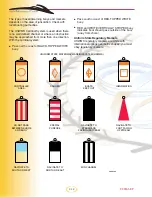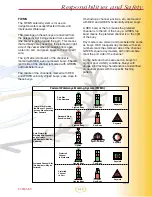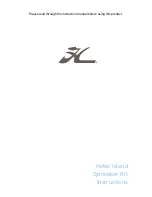
3-2
Boating Under the Influence
NOTICE: If the operator’s blood
alcohol content is 0.10% (0.08% in
some states) or above, violators are
subject to a civil penalty up to
$1,000.00 or criminal penalty up to
$5,000.00, one year imprisonment or
both. Operating a boat under the
influence can also result in a loss of
automotive driving privileges.
Do not operate your boat under the influence of
alcohol or other drugs. You are responsible for the
safety of your passengers.
FIRST TIME OPERATION
Your safety, the safety of your passengers, and
other boaters are among your responsibilities as
operator of this boat. Your boat must be in
compliance with USCG safety equipment
regulations. You should know how to react
correctly to adverse weather conditions, have
good navigation skills, and follow the “rules of the
road” as defined by the USCG and state, county
and local regulations.
We cannot stress enough the importance of
reading your propulsion unit operator’s manuals
and following the manufacturer’s instructions for
breaking in your engines.
!
WARNING
Read and understand this manual and the
propulsion unit operator’s manual, and be
sure that you understand all controls and
operating instructions before attempting
to operate the boat. Improper operation
can be extremely hazardous.
!
WARNING
Federal and state law prohibit operating a
boat under the influence of alcohol and
other drugs. These regulations are
actively enforced. Impaired operation may
result in severe personal injury or death.
Before each outing you should check all safety
equipment, such as fire extinguishers, PFDs,
flares, distress flags, flashlights and engine stop
switch. They should be operable, in good
condition, readily visible, and easily accessed.
Fueling
Take care not to spill gasoline. If gasoline is
accidentally spilled, wipe up all traces of it with dry
rags and immediately dispose of the rags properly
ashore. Spilled fuel may yellow the gelcoat finish
and damage gunwale trim.
When fueling:
1. Know your fuel tank capacity. Be sure to have
enough fuel to reach your destination. If
departing for an extended cruise, know the
availability of fuel along your route. Practice the
One Third Rule: one third to reach the
destination, one third to return and one third in
reserve.
2. Avoid fueling at night, except under well-lighted
conditions.
3. Moor your boat securely to the dock. Know the
location of the fire extinguisher in case of
emergency.
CAUTION
To prevent unwarranted engine damage,
refer to your propulsion unit operator’s
manual for recommended fuel type and
octane rating.
!
WARNING
All precautions must be taken every time
you fuel your boat, whether it’s gasoline
or diesel fuel. Diesel fuel is non-explosive,
but it will burn.
!
!
DANGER
Gasoline is extremely flammable and
highly explosive under certain conditions.
Stop the engines and generator, and do
not smoke or allow open flames or sparks
within 15 m (50 ft) of the fueling area.
Summary of Contents for 360
Page 1: ...Owner s Manual ...
Page 36: ...2 22 ...
Page 74: ...3 38 ...
Page 108: ...5 14 ...
Page 111: ...6 3 SERVICE LOG Date Hour Reading Service Repairs Performed Checklist Forms and Index ...
Page 112: ...6 4 FUEL LOG Date Gallons Hours Gallons Hour Date Gallons Hours Gallons Hour ...
Page 118: ...6 10 ...
Page 119: ......
















































